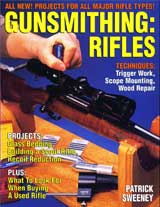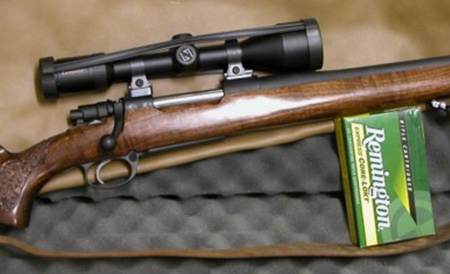We build custom rifles based on the customer’s wishes and pocketbook. We try to find out just what the client is trying to accomplish and tune the order to meet those needs.
Sometimes it is better to recommend that the client does some of the work himself; the satisfaction factor is pretty big on a gun that is a “partnership” between gunsmith and owner. If you’ve never had a rifle built here are a few tips that might save you some headaches and keep some of that stimulus money in your pocket. (Sorry, I couldn’t resist that one.)
THE ACTION
The centerpiece of any rifle is the action. If you have in mind what you want in terms of make and model, you can save a bunch of money right off the bat if you use an action you already have, as in from another rifle.
 Download the Digital Edition of Gunsmithing: Rifles by Patrick Sweeney. PDF Format. Download Now. |
We do this for clients all the time; if the bolt face diameter and cartridge length is the same for the new caliber as the old the change-over is simple. You can’t make a .223-sized action work for a 30/06 without major metalwork, but if the new caliber is compatible with the size of the action you’re on the way.
A standard .30/06 length action can be used for dozens of calibers, even those .308-length if a magazine cut-off is used and if the rim diameter is the same. Getting an action the right size for your intended cartridge is always better than modifying an action to fit the round.
Good Mauser actions abound, as do 700 Remingtons, 70 Winchesters, and 77 Rugers. The more modern actions of American manufacture can be had in various sizes for different classes of cartridges. Modern actions usually have been drilled and tapped for scope bases and usually have serviceable triggers and safeties. This will also save money on the semi-custom gun.
THE BARREL
Barrel blanks can be ridiculously expensive or downright cheap. Good, accurate and serviceable barrels can be had from a dozen manufacturers, the choice is yours to make based on your budget and needs. We’ve used about all of them and only once have ever seen a “bad” barrel, one that was actually too rough down the hole to shoot accurately. If you stick with a known brand like Shilen, Douglas, Hart, or any of the other “name” brands I doubt you will be disappointed.
Thin, lightweight barrels can be finicky and harder to find the proper load for than standard or heavy tubes. You should decide what bullet weight you intend to shoot in the gun and choose the twist accordingly, this is a decision that is very important. For instance, if you choose the .223 Remington caliber and want to shoot the newer heavy bullets over 55 grains get the fast twist tube, not the slow 1:12 of the old days.
I have a .223 that we built for groundhogs and 50 grain hollowpoints and with its 1:14 twist it will keyhole any bullets over 55 grains, splattering them all over the target at 100 yards. You can expect to pay from $250 to $400 to have a barrel threaded and chambered and fit to an action and this does not include bluing (if necessary) or drilling and tapping for sights.
Walt Hampton is a professional gunsmith and writer from Virginia. He and his son Wade operate Buck Mountain Rifle Works, manufacturing semi-finished gun stocks and building custom rifles on order. Visit his website at www.buckmountainrifleworks.com or write him at [email protected].


![Best Concealed Carry Guns In 2025 [Field Tested] Wilson Combat EDC X9S 1](https://gundigest.com/wp-content/uploads/Wilson-Combat-EDC-X9S-1-324x160.jpg)


![Best 9mm Carbine: Affordable PCCs [Tested] Ruger Carbine Shooting](https://gundigest.com/wp-content/uploads/Ruger-Carbine-Shooting-100x70.jpg)
![Best AR-15: Top Options Available Today [Field Tested] Harrington and Richardson PSA XM177E2 feature](https://gundigest.com/wp-content/uploads/Harrington-and-Richardson-PSA-XM177E2-feature-100x70.jpg)
